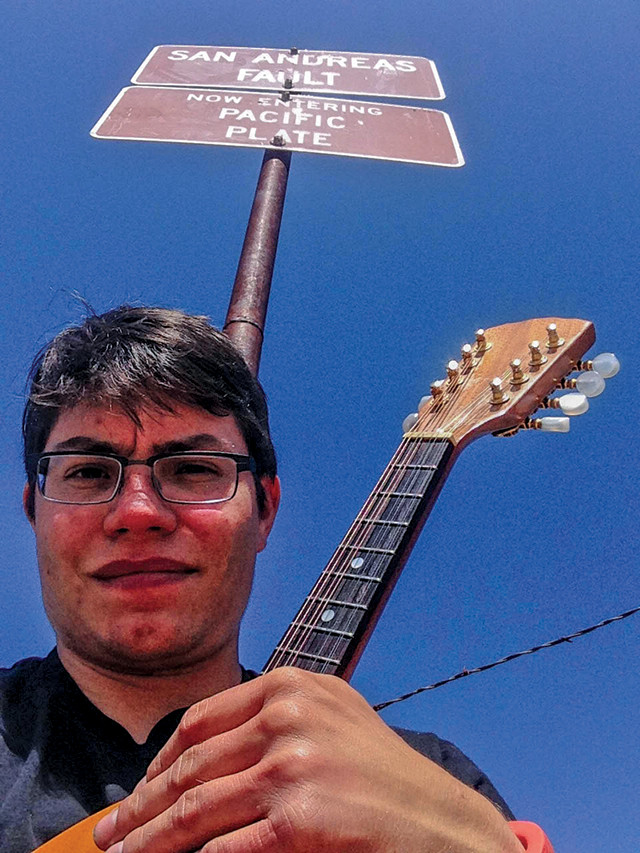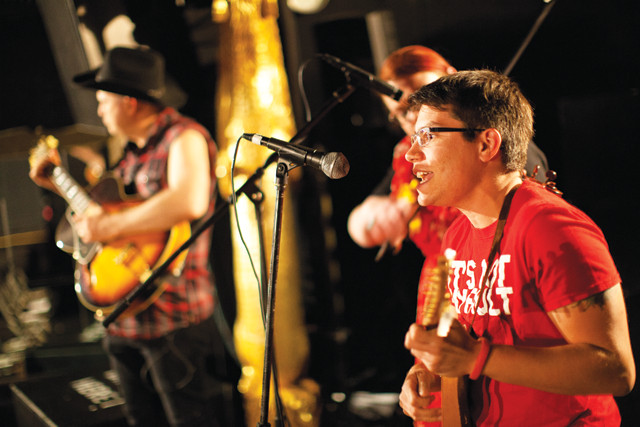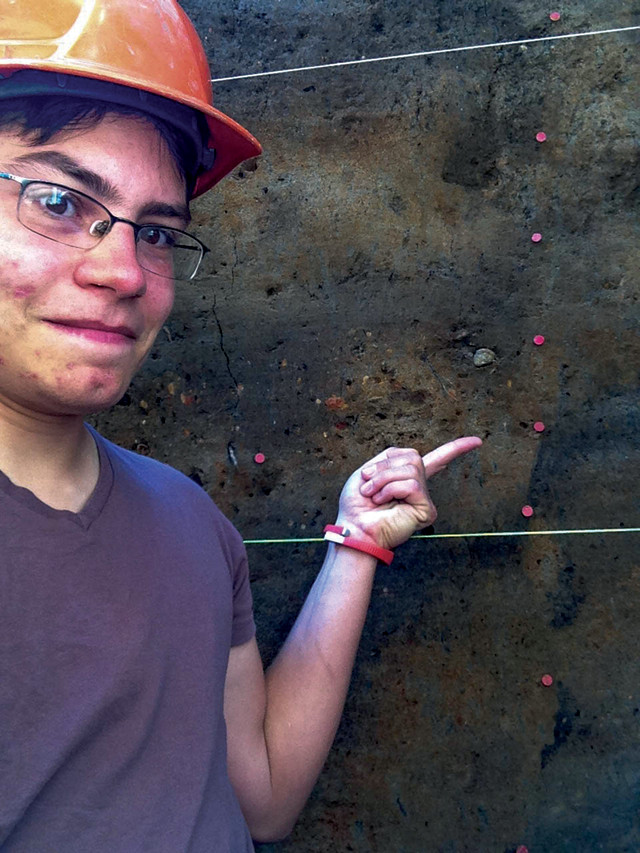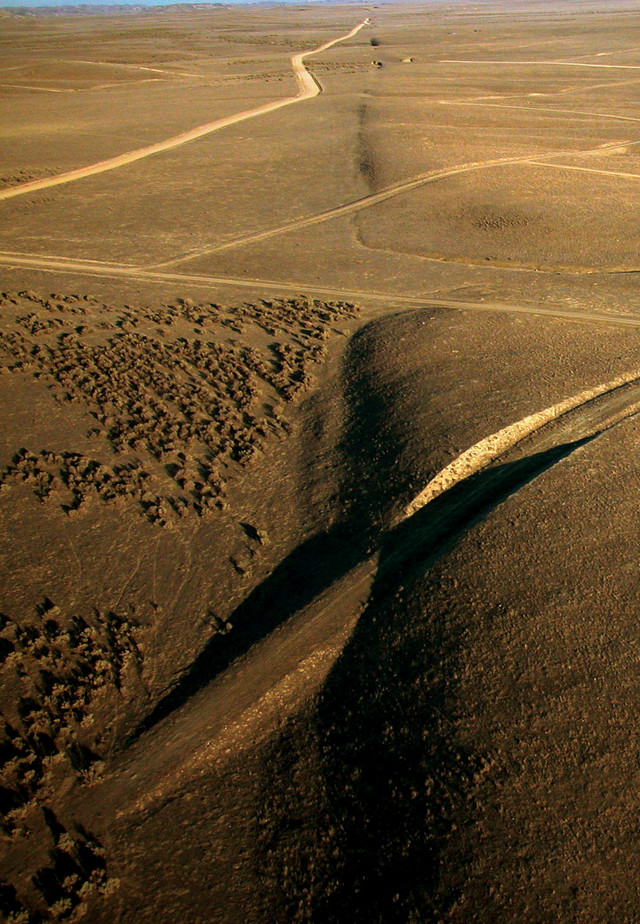
by Lucas Joel Tuesday, October 20, 2015

Julian Lozos at a bluegrass music festival in Parkfield, Calif., a town that sits atop the San Andreas Fault. Credit: Julian Lozos.
Julian Lozos, a postdoctoral researcher affiliated with both the U.S. Geological Survey and Stanford University, designs computer models that simulate earthquakes. As a graduate student at the University of California at Riverside (UC Riverside), Lozos discovered part of what makes the San Jacinto Fault — a major fault in Southern California underlying the homes of millions — tick. For this work, Lozos received the Outstanding Student Presentation award at the annual meeting of the Seismological Society of America three years in a row, an unprecedented accomplishment.
Lozos is also a musician who originally moved to California in 2006 to complete a master’s degree in music composition at UC Riverside. After a life-altering experience, though, he changed gears and began pursuing a doctorate in geophysics, which eventually led to him crossing paths with Lucas Joel, EARTH’s summer 2015 editorial intern, in the halls of the UC Riverside Department of Earth Sciences, where they overlapped during their respective times as graduate students.
Recently, Joel spoke with Lozos about the car accident that led him to geophysics, about drawing comics in which the main characters are geologic faults, and about Lozos’ new position teaching geology atop the Northridge Fault.
LJ: What do you study, and how do you study it?
JL: I study how faults work and interact with one another during an earthquake. Many recent and historic earthquakes have shown us that faults can work together in interesting ways, and I use computer model-generated quakes to study what makes the quakes tick. With real earthquakes, you know that they’ve happened, but you might not be able to tell which physical process caused one area to shake more than another, or what caused this part of the fault to slip more than that part of the fault. Using a computer, I can actually look at which initial conditions produce what specific earthquake effects, and I don’t have to sit and wait for the real fault to slip to see what happens.
LJ: Do you study plate boundary-scale faults, like the San Andreas, or do you focus on smaller faults or sets of faults?
JL: I mostly focus on sections of the San Andreas. In particular, I focus on the Inland Empire area of Southern California where the San Jacinto Fault — a very active and complex fault — joins with the San Andreas in the city of San Bernardino. I’ve also done some work on the Bartlett Springs Fault, which is in Mendocino County in Northern California.
LJ: If I drove along the San Jacinto Fault, how long would it take me to get from one end to the other?
JL: Well, this is Southern California, so it would depend on the time of day you’re driving. But if you were actually able to go 60 miles per hour, it’d take you maybe an hour to get from one end of the fault to the next. But for an earthquake, that trip takes only a few seconds.

Lozos plays with his bluegrass band, Mesquite and Mustard, in San Francisco. Credit: Kevin Wong, rightangleimages.com.
LJ: What makes the San Jacinto Fault interesting?
JL: The San Jacinto Fault is less than a million years old. My interest is in how it accommodates stress along the San Andreas today, and how it has accommodated stress in the past. It’s important to understand how this fault works because so many people live in these areas. The Inland Empire is a large, densely populated area with a ton of faults in it. The Los Angeles Basin is a bowl of [gelatin] filled with faults. Setting up a model for the San Jacinto was difficult, but overall it’s been very fulfilling and fun. There were a lot of things that I didn’t expect, like when we found that it’s easier for the northernmost part of the San Jacinto to rupture than the southernmost.
LJ: How does your work fit in with the larger community of fault modelers?
JL: People like me use dynamic models, which incorporate the full physics of how faults work in order to come up with a model earthquake to figure out what, exactly, the fault is going to do. That’s a small subset of people — maybe fewer than 100 in the world. Within that group, I’m interested in bringing real-world geologic and seismologic data to inform how I set up my models. I like to use paleoseismic data, which give us a sense of when and where past earthquakes happened on different parts of the fault. If this fault slips this much this often, what processes helped lead to that? My work includes equations dealing with wave motion, elasticity, stress transfer … The result is a full, detailed, physical calculation, the outputs of which will result in an earthquake.
LJ: What is it about this field that excites you?
JL: My field is the study of how the place where we live moves and changes and sorts out its own equilibriums. It’s fascinating to me how the planet works, and that there are tools now to look at — from the comfort of your own office — the processes that affect large-scale arrangements of the planet’s crust. Also fascinating to me is the fact that it affects everyone. Whether or not you care about the science of earthquakes, if you live somewhere like California, earthquakes matter.

Lozos in a trench that crosses the San Andreas Fault in Woodside, Calif. Credit: Julian Lozos.
LJ: How did you make the shift from studying music to studying geophysics?
JL: Music school was burning me out. Being creative on demand was exhausting, and I didn’t work well that way. If you want to try to make a living as a composer, you have to compose music even if you have no ideas. Music academia also isn’t necessarily filled with the music you want to listen to, but with music that is intellectually stimulating. That, and there is a constant analysis of the music going on, which eventually made enjoying the songs difficult.
LJ: You were in a car accident while in music graduate school. How did that affect you?
JL: In 2007, on my way to meet up with a friend to take a road trip along the San Andreas Fault, I flipped my car off the 101 freeway. I rolled down an embankment, and crashed upside-down in the dirt. My car was totaled, but I only pulled a muscle in my neck. I’m still amazed that I wasn’t more injured, although I was wearing my seatbelt. At that moment, when I knew I could’ve died — which scared the living daylights out of me — I thought, “OK, I’m not dead, what do I want to do now?” I realized then that I could die any day, and so I wanted to do something that I actually wanted to do, which was to study earthquakes.
LJ: But you finished your music master’s anyway?
JL: Yes, I knew I wanted to switch paths, but it was a question of how I wanted to do it. I knew I wouldn’t forgive myself if I didn’t finish my music master’s. But in the second year of that program, I took or audited a whole bunch of different science courses.
LJ: Are you in a band right now?
JL: Yes, I play mandolin in a trio called Mesquite and Mustard that plays what we jokingly describe as drunk cowboy jazz, because we’re always drinking craft beer. We’re beer snobs. The band’s named after barbecue sauce [laughing], even though the fiddle player’s a vegetarian who doesn’t eat much barbecue. We play a lot around San Francisco, and we play a lot of songs about trains.
LJ: Have you ever played any songs about earthquakes?
JL: Not with Mesquite and Mustard, but at UC Riverside I was part of a band called the Rivertucky Ramblers and I convinced them to do a song about an earthquake. The song, though, had a nonstandard chord progression for bluegrass, and if you bring a tune to a session that has too much complexity, and it’s hard for someone who doesn’t know the tune to follow, it’s called a jam-buster. This is also true in earthquake modeling: An earthquake can keep going fairly easily on a fault that’s somewhat simple, but as soon as the rupture encounters some kind of complexity in the fault plane, that may actually stop an earthquake in its tracks. So, it’s a jam-buster fault.

The San Andreas Fault as seen in the Carrizo Plain in Southern California. Lozos studies the San Jacinto Fault, which abuts the San Andreas. Credit: U.S. Geological Survey.
LJ: Have you played anywhere recently?
JL: I went to a bluegrass festival in Parkfield, Calif., which is a tiny town — population 18 — that sits directly on top of the San Andreas Fault. The people of Parkfield are kind of like earthquake cowboys. The town averages a magnitude-6 quake every 22 years, which is a short enough recurrence time that there was a huge exercise to try to predict when the next quake would occur there. There was a quake in 1966, and people said the next one would be in 1984 or 1986, and it wasn’t. The quake didn’t happen until 2004. I got to jam while sitting on top of the San Andreas, and had an amazing time.
LJ: You’ve just been hired as an assistant professor at California State University at Northridge (CSUN). When do you start?
JL: I start in January 2016. I’m going to be living on top of a known killer fault: Northridge. I’ll be teaching undergraduates and will eventually have master’s students, too. There’s a good balance at CSUN between teaching and research. There are a lot of geologists in my new department who study active tectonics and fault morphology, and I’m looking forward to working with them and to using their data in my models. The collaboration opportunities will be great.
LJ: Do you ever take your excitement for earthquakes outside academia?
JL: I’ve done a lot of outreach, including presentations at schools and museums. Six years ago, I started a comic book where the characters are faults, or personifications of faults. I want people to see earthquakes not as bogeymen, but as things that can be studied and understood. I want people to talk about faults in a frank way. Earthquakes are not trying to kill you, even though they’re something we should be wary of. For instance, in the comic, the San Andreas is a landscape artist, and he made this landscape that you’re living on. He’s not a bad guy — he’s just doing his thing.
© 2008-2021. All rights reserved. Any copying, redistribution or retransmission of any of the contents of this service without the expressed written permission of the American Geosciences Institute is expressly prohibited. Click here for all copyright requests.